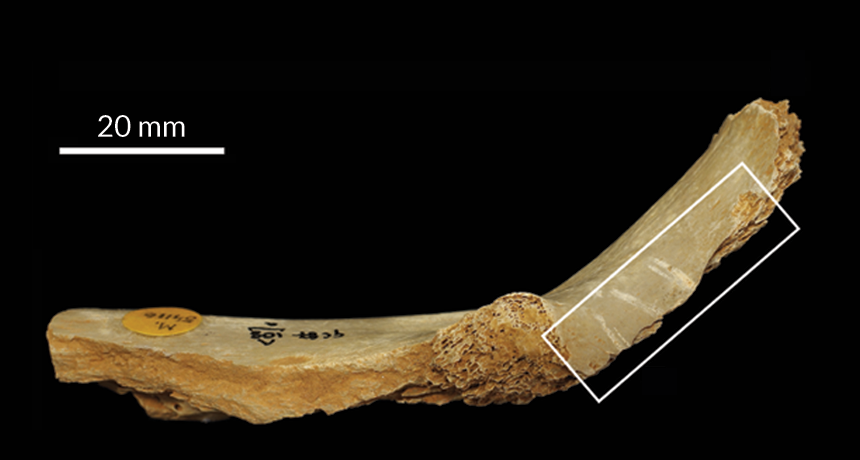Ritual cannibalism occurred in England 14,700 years ago
Gnaw and butcher marks found on human leg, rib, other bones

CANNIBAL CHEW Human tooth marks and pounding damage (in boxed area) on a 14,700-year-old human leg bone excavated from a British cave indicate that ritual cannibalism was practiced there, researchers say.
S. Bello/Journal of Human Evolution 2015
A grisly ritual, at least by modern standards, played out in a British cave about 14,700 years ago.
Hunter-gatherers took the bodies of at least six of their deceased comrades to what’s now called Gough’s Cave and ate them as part of a burial rite, say biological anthropologist Silvia Bello of the Natural History Museum in London and her colleagues. Microscopic analyses show that these bodies, presumably of individuals who died of natural causes, were butchered much like those of nonhuman animals found in the same cave, Bello’s team reports April 15 in the Journal of Human Evolution.
Human tooth marks consistent with chewing appear on human ribs and other lower-body bones from Gough’s Cave, as do stone-tool incisions. Limb bones and other skeletal parts were broken with pounding stones to obtain marrow, the researchers contend.
A Bello-led team reported in 2011 that human remains at Gough’s Cave included the top parts of three skulls that had apparently been used as drinking cups. Taken together, these discoveries point to some type of cannibalistic practice related to treatment of the dead, the scientists conclude.
“This is possibly the clearest known archaeological example of ritualistic cannibalism,” Bello says.
Her team plans to conduct microscopic studies of scattered human bones at other European sites that, like Gough’s Cave, contain artifacts from the Magdalenian culture. That culture lasted from around 15,000 to 12,000 years ago. Many of those bones also bear stone-tool marks and were pounded into pieces. Some researchers have argued that these finds are leftovers of cannibalistic practices. Other say it’s more likely that flesh was removed from dead bodies before final burial of bones, but not eaten.
Butchered human bones at a roughly 7,000-year-old farming village in Germany have also been interpreted as either remnants of cannibalism or ceremonial reburial (SN: 1/2/10, p. 10).
Human tooth marks and related damage on human bones from Gough’s Cave provide “compelling evidence for exhaustive butchery and cannibalism of at least six individuals,” says archaeologist Paul Pettitt of Durham University in England, who did not participate in the new study.
The human remains at Gough’s cave date to a time when England’s climate was shifting from mild to cold, Pettitt says. If animal prey and edible plants were becoming scarce, cannibalistic burial rituals may have been partly inspired by hunger, he suggests.
Gough’s Cave was discovered in the 1880s. Several excavations in the cave have been conducted since then, with the latest taking place from 1986 to 1992. Workers have unearthed human bones, butchered bones of wild horses and other animals, as well as a variety of stone, bone, antler and ivory artifacts typical of the Magdalenian culture.
Bello’s team studied the entire collection of Magdalenian-era human bones from Gough’s Cave — 37 skull pieces, four jaw fragments and 164 lower-body fossils. These bones come from three adults, two teenagers and a child.
Microscopic studies of the bones enabled the scientists to produce 3-D digital models of tool and tooth marks. Long cracks, crushed patches, shallow tooth impressions and other bone marks produced by human chewing appeared on 87 lower-body bones. A majority of lower-body bones contained stone-tool incisions characteristic of butchery. Nearly one-third of lower-body bones displayed pounding damage from marrow removal.
Radiocarbon dating of excavated bones indicates that no more than two or three generations of Magdalenian hunter-gatherers practiced ritual cannibalism at Gough’s Cave.







